Is Rabbit Safe to Eat
Rabbit is safe to eat when properly handled and cooked. You'll find it's a lean, protein-rich meat with numerous health benefits. To guarantee safety, cook rabbit thoroughly to an internal temperature of 165°F. Be cautious with wild rabbits, as they may carry diseases like tularemia. Inspect the liver for signs of illness before cooking. Practice good hygiene during preparation to prevent contamination. Rabbit offers a nutritious alternative to traditional meats, being low in fat and high in essential vitamins and minerals. When sourced from reputable suppliers and prepared correctly, it's a safe and healthy addition to your diet. Exploring rabbit's culinary potential can open up new gastronomic adventures.
This post may contain affiliate links. If you make a purchase through these links, I may earn a commission at no additional cost to you. Additionally, portions of this post may be generated using artificial intelligence (AI) technology. While we strive for accuracy, please be aware that AI-generated content may not always be perfect and should be fact-checked when necessary.
The Spatula Scoops
- Rabbit meat is safe to eat when properly handled and cooked to an internal temperature of 165°F (74°C).
- It's a nutritious, lean protein source rich in vitamins and minerals, with health benefits including weight management support.
- Proper handling and preparation techniques are crucial to prevent foodborne illnesses and contamination.
- Sourcing from reputable suppliers or following hunting regulations ensures safer consumption of rabbit meat.
- Cultural perspectives on rabbit consumption vary, but it's recognized as a sustainable protein source in many cuisines.
Nutritional Profile of Rabbit Meat
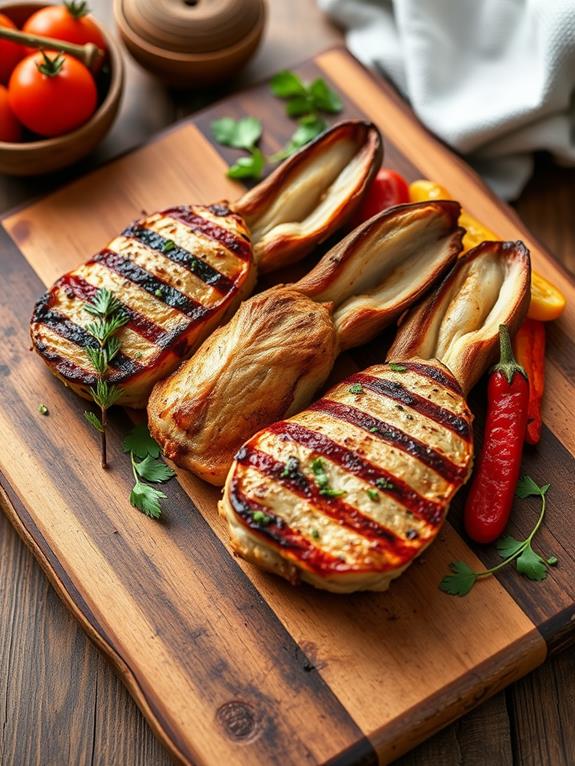
When it comes to the nutritional profile of rabbit meat, you're looking at a powerhouse of protein and essential nutrients. You'll find approximately 29.1 grams of protein per 100 grams of rabbit meat, making it an excellent choice for maintaining muscle mass and feeling full. Notably, rabbit meat also has a lean quality similar to some products derived from corn, such as corn syrup, which is fundamental in many culinary applications. If you're watching your fat intake, you'll be pleased to know that rabbit meat is relatively low in fat, containing only 6-7 grams per 100 grams.
Rabbit meat is also rich in B vitamins, particularly B12 and niacin. These vitamins play vital roles in red blood cell production and energy metabolism. You'll also benefit from a range of essential minerals, including selenium, phosphorus, potassium, and iron. These minerals support various bodily functions, from immune system health to bone strength.
For those managing their weight, rabbit meat offers a favorable calorie-to-nutrient ratio. With about 197 calories per 100 grams, you're getting a substantial amount of nutrition without excessive energy intake. This makes rabbit meat a smart choice for balanced, nutrient-dense meals that can help you meet your dietary goals while enjoying a flavorful protein source.
Safety Considerations for Eating Rabbit
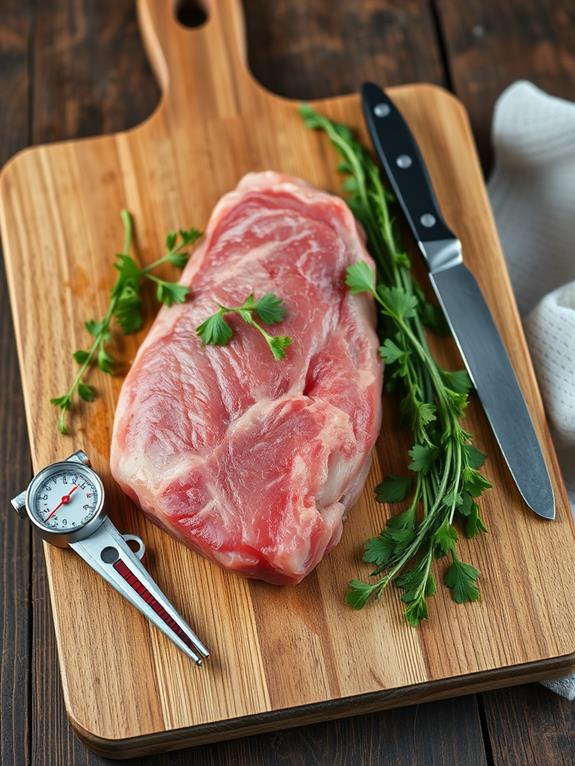
Safety Considerations for Eating Rabbit
Three key safety considerations are vital when eating rabbit. First, proper cooking temperature is critical. Guarantee your rabbit meat reaches an internal temperature of 165°F to eliminate harmful bacteria and parasites. This step is non-negotiable for safe consumption. Additionally, awareness of safe food handling practices is important, particularly when dealing with meats to prevent contamination and foodborne illness food safety guidelines.
Second, exercise caution when handling wild rabbits. They may carry tularemia, a disease transmitted through bites or contact with infected animals. When cleaning wild rabbits, always wear gloves to protect yourself from potential pathogens and blood exposure. Additionally, inspect the liver for any lesions, which could indicate disease presence.
Lastly, don't let old wives' tales deter you from eating rabbit before the first frost. While some believe this increases parasite risks, proper cooking methods effectively mitigate these concerns. However, it's important to maintain proper hygiene throughout the preparation process.
Proper Handling and Preparation Techniques
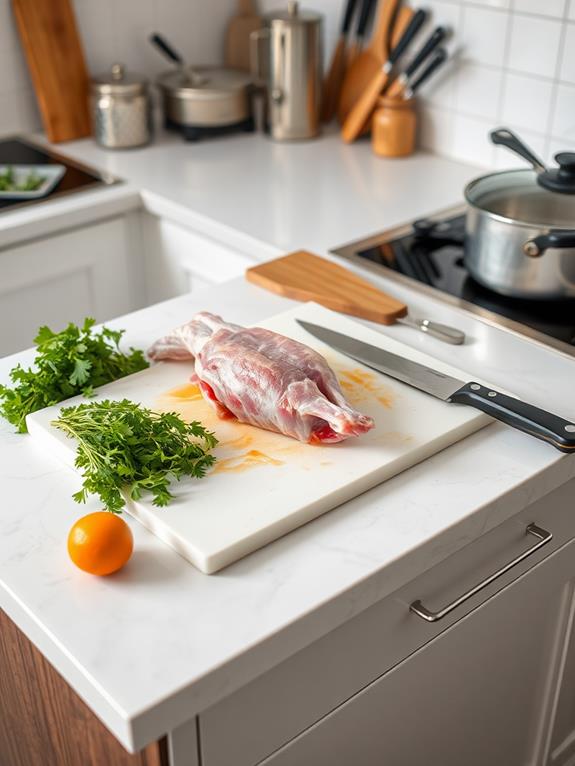
Proper handling and preparation of rabbit meat is essential for guaranteeing food safety and maximizing flavor. When working with rabbit, you'll need to take several precautions to protect yourself and guarantee the meat is safe to eat. For instance, many cooks prefer simple recipes that highlight the natural taste of the meat, akin to the philosophy of creating nourishing meals with whole ingredients found in healthy dinner recipes. Start by wearing latex or nitrile gloves to prevent direct contact with blood and potential pathogens. As you clean the rabbit, inspect the liver for any abnormalities that might indicate illness, such as tularemia. Once cleaned, store the meat immediately in the refrigerator or freezer to prevent bacterial growth.
When you're ready to cook, guarantee the rabbit reaches an internal temperature of 160°F to eliminate harmful bacteria and parasites. This step is vital for food safety.
After handling rabbit, thoroughly clean all tools and surfaces with hot, soapy water to prevent cross-contamination with other foods. This includes cutting boards, knives, and countertops.
Health Benefits of Consuming Rabbit
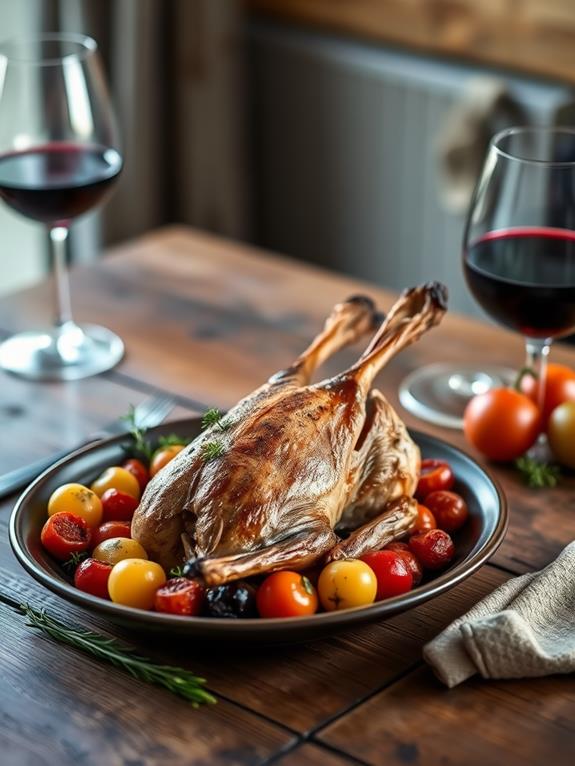
You'll find that rabbit meat offers several health benefits when incorporated into your diet. It's an excellent source of high-quality protein, which is crucial for muscle maintenance and repair. Additionally, rabbit provides a wealth of essential vitamins and minerals, particularly B vitamins and selenium, while its lean nature makes it a heart-healthy meat option that can support your overall well-being. As with other game meats, proper handling and cooking techniques are important to guarantee safety, as with squirrel meat.
High-Quality Protein Source
Rabbit meat stands out as an exceptional source of high-quality protein, packing a whopping 29.1 grams per 100-gram serving. This makes it an excellent choice for maintaining muscle mass and promoting satiety. When you're looking to boost your protein intake, rabbit meat should be on your radar as one of the first options to contemplate.
Let's break down the nutritional profile of rabbit meat:
| Nutrient | Amount per 100g | % Daily Value |
|---|---|---|
| Protein | 29.1g | 58% |
| Calories | 197 | 10% |
| Fat | 6-7g | 9-11% |
| Vitamin B12 | High | Varies |
| Selenium | High | Varies |
As you can see, rabbit meat is not only high in protein but also low in calories and fat. This combination makes it an ideal food for weight management and muscle building. The high protein content helps you feel fuller for longer, potentially reducing your overall calorie intake throughout the day. Additionally, rabbit meat is rich in essential vitamins and minerals, particularly B vitamins and selenium, contributing to your overall nutritional needs.
Essential Vitamins and Minerals
Beyond its impressive protein content, rabbit meat boasts a rich array of essential vitamins and minerals that can greatly boost your overall health. You'll find it's an excellent source of B vitamins, particularly B12, which is vital for red blood cell production and maintaining your energy levels. This makes rabbit meat an ideal choice for those looking to increase their stamina, especially as the first frost approaches and you need that extra lift.
Selenium, a powerful antioxidant, is abundantly present in rabbit meat. It supports your immune system, helping you ward off illnesses. The high phosphorus content contributes to strong bones and efficient energy production, while potassium aids in regulating your body's fluid balance and muscle contractions. If you're watching your weight, you'll appreciate that rabbit meat is a low-calorie protein option, making it perfect for balanced diets. The iron content in rabbit meat is also significant, as it helps transport oxygen throughout your body, enhancing your overall energy and physical performance. By incorporating rabbit into your diet, you're giving your body a well-rounded nutritional boost.
Heart-Healthy Lean Meat
Three key factors make rabbit meat a heart-healthy option for those looking to improve their cardiovascular well-being. First, it's exceptionally low in fat, containing only 6-7 grams per 100 grams. This makes it an ideal choice for those aiming to reduce their fat intake while still enjoying a flavorful protein source. Second, rabbit meat is rich in omega-3 fatty acids, which can help lower cholesterol levels and support healthy blood pressure regulation. Finally, its low calorie content of about 197 calories per 100 grams makes it an excellent choice for weight management, an essential factor in maintaining heart health.
Here's a breakdown of rabbit meat's heart-healthy benefits:
| Nutrient | Benefit | Impact on Heart Health |
|---|---|---|
| Low Fat | Reduces overall fat intake | Lowers risk of heart disease |
| Omega-3s | Supports cardiovascular health | Helps regulate blood pressure |
| High Protein | Promotes satiety | Aids in weight management |
| B Vitamins | Supports metabolic health | Enhances overall heart function |
| Low Calories | Assists in weight control | Reduces strain on the heart |
Potential Risks and Precautions
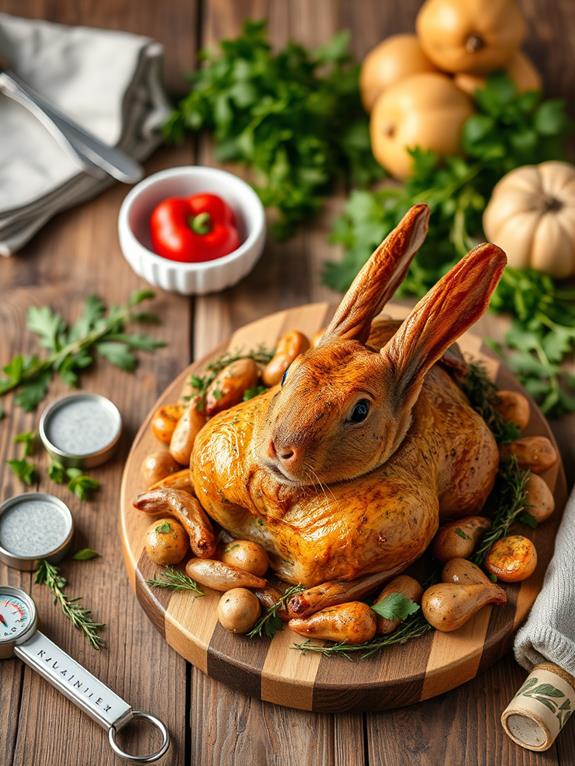
When considering rabbit as a meal option, it's essential to be aware of a few key risks and take necessary precautions. While rabbit meat is generally safe to eat, you should be mindful of potential health hazards, including the risk of foodborne pathogens. Proper cooking methods, like guaranteeing the meat reaches a minimum internal temperature of 165°F, can greatly mitigate such risks, much like the importance of cooking fish to a safe temperature as highlighted in health benefits of cooking. One such risk is tularemia, a disease transmitted through infected rabbit tissue. To minimize this risk, always wear latex or nitrile gloves when cleaning rabbits to avoid skin contact with potentially contaminated blood or tissue.
Before cooking, carefully inspect the rabbit's liver for any signs of lesions or infection. If you notice anything unusual, it's best to discard the meat. To guarantee safe consumption, cook rabbit thoroughly to an internal temperature of 165°F. This eliminates the risk of foodborne pathogens and parasites, regardless of the season.
Cooking Methods for Rabbit
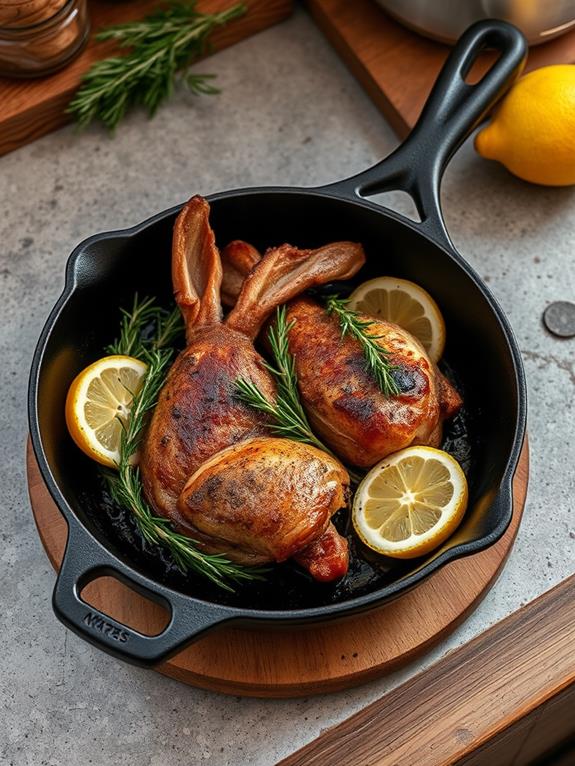
When cooking rabbit, you'll find that braising and slow-cooking techniques are excellent choices for achieving tender, flavorful meat. These methods allow the rabbit to cook gently over time, breaking down tough fibers and infusing it with the flavors of herbs, vegetables, and spices you've added to the pot. For an added depth of flavor, consider incorporating ingredients like Viva Naturals Organic Cacao Powder into your recipe. If you prefer a quicker cooking method, grilling and roasting can also produce delicious results, but you'll need to take care not to overcook the lean meat, which can dry out easily.
Braising and Slow-Cooking Techniques
Over time, braising and slow-cooking have become popular techniques for preparing rabbit, thanks to their ability to transform this lean meat into a tender, flavorful dish. When braising rabbit, you'll want to cook it slowly in a covered pot with a small amount of liquid. This method helps tenderize the meat and infuse it with flavor from the cooking liquid and seasonings.
To achieve the best results, start by searing the rabbit in a hot pan. This creates a rich, caramelized crust that adds depth to the final dish. Then, add your chosen liquid – broth, wine, or a flavorful sauce – along with herbs, spices, and aromatic vegetables like onions and garlic. Slow-cook the rabbit at low temperatures, around 250°F to 300°F, for an extended period. This allows the collagen in the meat to break down, resulting in a juicy and tender texture.
You can experiment with various sauces when braising rabbit, such as mustard-based, tomato, or creamy combinations. This versatility allows you to get creative in the kitchen and explore different flavor profiles while ensuring your rabbit dish is always delicious and satisfying.
Grilling and Roasting Methods
Grilling and roasting offer delicious alternatives for preparing rabbit, allowing you to achieve a crispy exterior while maintaining a juicy interior. When grilling rabbit, start by marinating the meat to enhance flavor and tenderize it. Use indirect heat to prevent overcooking the exterior before the inside reaches the safe internal temperature of 160°F. This method guarantees a juicy result and eliminates harmful bacteria.
For roasting, preheat your oven to 375°F and cook the rabbit for 20-30 minutes per pound. This technique results in even cooking and a tender, moist finished product with a beautifully browned exterior.
| Cooking Method | Temperature | Time | Tips |
|---|---|---|---|
| Grilling | 160°F (internal) | Varies | Use marinade, indirect heat |
| Roasting | 375°F | 20-30 min/lb | Even cooking, moist result |
Both grilling and roasting methods provide safe and delicious ways to prepare rabbit. Remember to always check the internal temperature to verify food safety. By following these guidelines, you'll be able to enjoy perfectly cooked rabbit with confidence, whether you're grilling outdoors or roasting in the oven.
Sourcing Safe Rabbit Meat
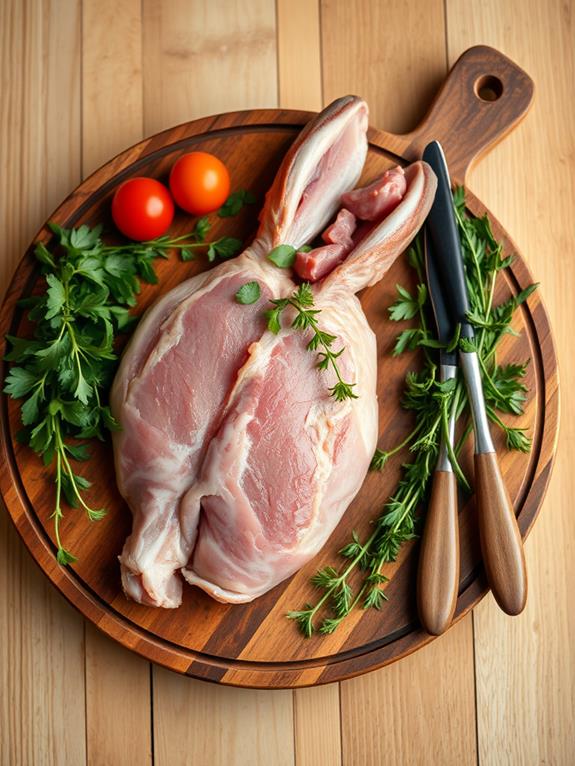
Tracking down safe rabbit meat can be a bit of a challenge, but it's vital for enjoying this lean protein without worry. Your local butcher shop is often a great place to start, as they can provide information about the meat's origin and processing. When sourcing rabbit, it's important to verify that it's been handled in USDA-approved facilities to guarantee food safety and reduce contamination risks. Additionally, using sharp knives can make your preparation more efficient and enjoyable; consider investing in quality options like a Global Tool G-55946 3pc Knife Set for ideal cutting performance.
Don't hesitate to ask questions about the rabbits' breeding and living conditions. Higher welfare practices often result in healthier meat. If you're considering wild rabbit, make sure it's been hunted legally and sustainably, adhering to local regulations on seasons and bag limits. Farmers' markets can be another excellent source for fresh, locally-raised rabbit.
Before purchasing, inspect the meat for proper storage. It should be refrigerated or frozen to prevent bacterial growth. Remember, safety doesn't end with sourcing; proper handling and cooking are equally important. By following these guidelines, you'll be well on your way to enjoying safe, high-quality rabbit meat in your culinary adventures.
Seasonal Factors Affecting Rabbit Safety
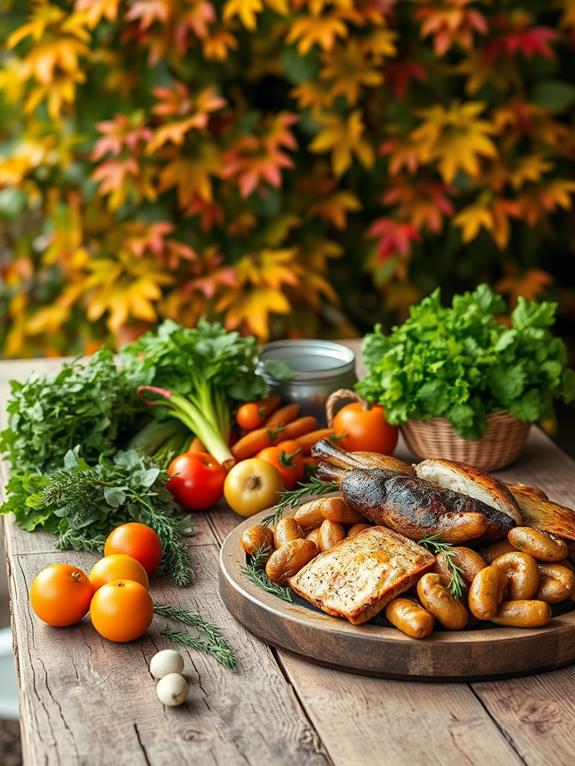
You might've heard that rabbit is safer to eat after the first frost, but this belief isn't entirely accurate. While colder temperatures can affect some parasites, the safety of rabbit meat depends more on proper handling and cooking techniques than on the season. For those engaged in meal prep, utilizing proper storage methods can enhance food safety, ensuring ingredients are well-preserved, much like how Souper Cubes can help with meal storage. It's essential to understand that seasonal hunting regulations and the overall health of the rabbit population play a more significant role in determining when it's appropriate to harvest and consume wild rabbits.
Temperature Effects on Parasites
Many hunters and outdoor enthusiasts believe that it's safer to eat wild rabbits after the first frost. This idea stems from the notion that cold weather kills parasites, particularly intestinal worms that may thrive during warmer months. However, it's important to understand that while frost can eliminate some external parasites, it doesn't affect worms already present inside the rabbit.
To help you grasp the relationship between temperature and parasites, consider this table:
| Temperature | External Parasites | Internal Parasites |
|---|---|---|
| Warm | Thrive | Thrive |
| Cool | Reduced activity | Unaffected |
| Freezing | Die off | Unaffected |
| Cooking | Die off | Die off |
| Room temp | Can survive | Can survive |
As you can see, cooking is the most effective method for eliminating parasites, regardless of the season. While many hunters avoid consuming rabbits from April to September due to perceived risks, thorough cooking can make rabbit meat safe year-round. It's vital to inspect the rabbit for signs of illness, such as irregular liver spots, which may indicate a parasitic infection. If you notice these signs, it's best to discard the rabbit to guarantee your safety.
Seasonal Hunting Regulations
Safety considerations for consuming wild rabbits are intrinsically linked to seasonal hunting regulations. These rules aren't arbitrary; they're designed to protect both hunters and consumers. You'll find that most states have specific seasons for rabbit hunting, typically aligning with colder months. This timing isn't just about wildlife management; it's also about your health.
The "first hard frost" is often considered a vital marker for safe rabbit consumption. After this point, the risk of parasites and diseases decreases considerably. You might have heard of the "R rule," suggesting you should only eat rabbits in months containing the letter "R" (September to April). While this isn't scientifically proven, it does coincide with cooler temperatures that reduce health risks.
During warmer months, especially from April to September, you're more likely to encounter rabbits carrying diseases like tularemia due to increased flea activity. Always check state-specific regulations for legal hunting seasons and permitted weapons. When you harvest a rabbit, inspect it carefully for signs of illness, such as white spots on the liver, to confirm it's safe for consumption.
Frost's Impact Debunked
Despite popular belief, the impact of frost on rabbit safety has been largely debunked. You might have heard that rabbits harvested before the first frost are unsafe to eat due to parasites, but this claim lacks scientific support. In fact, the idea that frost kills worms in rabbits is a myth; these parasites aren't affected by cold weather once they're present in the animal.
You'll also want to disregard the old saying about avoiding rabbit meat during months without an "R." Parasites can exist in rabbits year-round, so this rule doesn't hold up to scrutiny. Instead of focusing on seasonal timing, you should pay attention to the rabbit's liver condition. White spots on the liver could indicate infections like tularemia, which is a more essential factor in determining whether the meat is safe for consumption.
Ultimately, proper cooking methods are your best defense against health risks, regardless of when you harvest the rabbit. By thoroughly preparing and cooking the meat, you'll effectively mitigate any potential dangers, making seasonal considerations less relevant to food safety.
Regulations and Guidelines for Rabbit
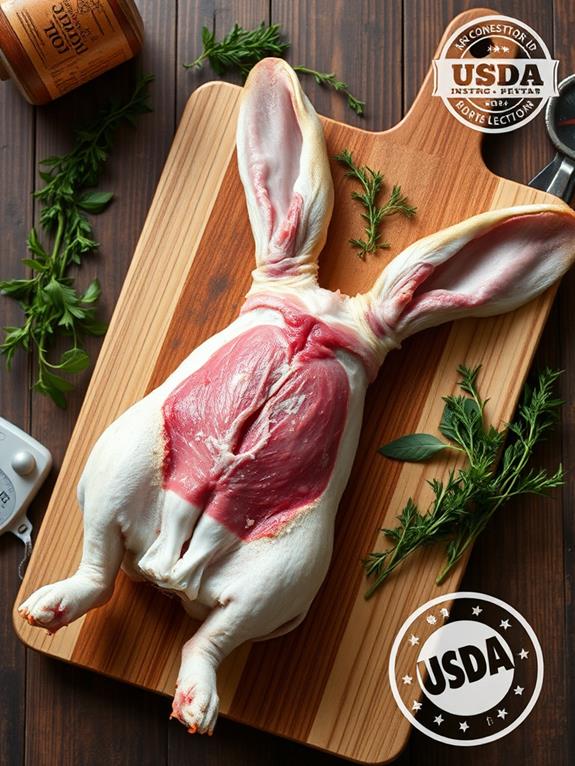
Before you set out to hunt rabbits, it's important to understand and follow the regulations and guidelines in your area. Most states require specific hunting licenses, and it's significant to research local rules before planning your hunt. You'll need to familiarize yourself with legal hunting methods, hours, and daily harvest limits, which can vary considerably by location. Additionally, be aware of the potential health risks associated with consuming wild game, as proper cooking techniques are critical to avoid foodborne illnesses health risks associated with undercooked meat.
Be aware that some areas may restrict the types of firearms or traps you can use for rabbit hunting. Penalties for non-compliance can be severe, so it's important to stay informed and adhere to all regulations. Local wildlife agencies regularly update information on rabbit populations and conservation efforts, helping to promote sustainable hunting practices.
If you're not interested in hunting but still want to try rabbit meat, consider checking farmers markets in your area. Some may offer locally sourced rabbit meat that's been harvested according to regulations. Whether you're hunting or purchasing, understanding these guidelines is significant for both legal and ethical reasons. Always prioritize safety and sustainability when considering rabbit as a food source.
Cultural Perspectives on Rabbit Consumption

Cultural attitudes towards rabbit consumption vary widely across the globe. In many Western cultures, particularly the United States, you'll find a strong "bunny taboo" that complicates the acceptance of rabbit as food. This stems from the emotional connection people have with rabbits as cute, furry pets. As a result, you'll need to make sure you're aware of these cultural sensitivities when discussing rabbit meat. The push for sustainable eating practices has also led to a growing interest in eco-friendly kitchen utensils, such as eco-friendly spoons, which complement the movement towards local and ethically sourced foods.
However, Mediterranean and indigenous American cuisines have long embraced rabbit as a versatile and nutritious protein source. Despite its nutritional benefits and sustainability, rabbit meat remains a niche option in American dining culture. Even as plant-based diets and whole-animal cooking gain popularity, the cultural resistance persists.
Interestingly, the COVID-19 pandemic has sparked renewed interest in home-raised rabbit production. This shift towards sustainable and local food systems is gradually changing perceptions around rabbit consumption. As you explore different culinary traditions, you'll find that rabbit meat offers a unique blend of flavor and nutrition, challenging the cultural taboos that have long surrounded it in some societies.
Frequently Asked Questions
When Should You Not Eat Rabbits?
You shouldn't eat rabbits when they show signs of illness, like white spots on the liver. It's best to avoid wild rabbits harvested before the first frost due to potential parasites and diseases. Summer-caught rabbits may carry higher risks from fleas and ticks, which can transmit diseases like tularemia. While some believe you shouldn't eat rabbit in months without an "R," there's no strong scientific evidence for this. Always cook rabbit thoroughly to 165°F to reduce health risks.
How to Know if a Wild Rabbit Is Safe to Eat?
To determine if a wild rabbit is safe to eat, you'll need to check a few things. First, verify you're hunting during the appropriate season. When cleaning the rabbit, wear gloves and inspect it for signs of illness, like liver lesions or unusual spots. Cook the meat thoroughly to 160°F to kill any harmful bacteria. Avoid rabbits shot in areas with lead pellets. Always follow proper skinning and cleaning techniques to enhance safety and reduce the risk of disease transmission.
Is Rabbit Food Safe for Humans?
Rabbit food isn't safe for human consumption. It's specifically formulated for rabbits' nutritional needs and digestive systems. While it may not be toxic, it lacks essential nutrients humans require and could contain ingredients that aren't processed well by your body. Consuming rabbit food might lead to digestive issues or nutrient deficiencies. If you're curious about unconventional foods, it's best to stick to those designed for human consumption. Always prioritize a balanced diet with foods meant for people.
Is Rabbit the Healthiest Meat?
While rabbit meat is nutritious, it's not necessarily the healthiest meat overall. You'll find it's high in protein and low in fat, which are great qualities. It's also rich in B vitamins and essential minerals. However, other lean meats like chicken or turkey offer similar benefits. The healthiest meat for you depends on your individual dietary needs and preferences. It's best to consult a nutritionist for personalized advice on incorporating various protein sources into your diet.





